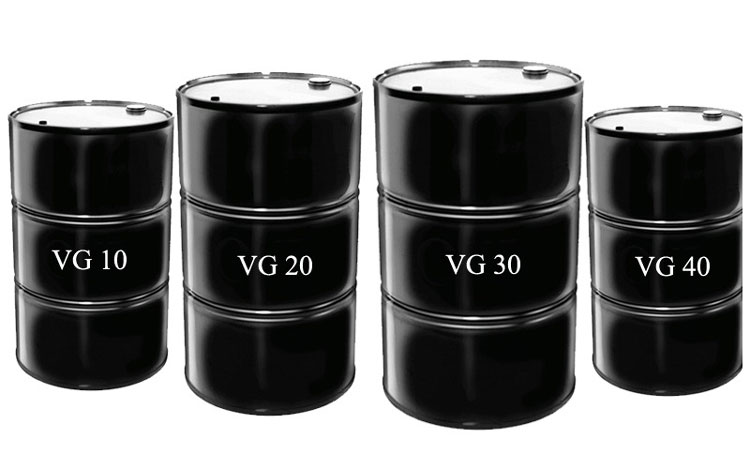Viscosity grade bitumen refers to classifications based on the flow characteristics of the bitumen at specific temperatures. Understanding these grades is essential in road construction, industrial sealing, and asphalt mix design, where temperature, traffic load, and durability are important factors. This type of bitumen is more reliable than other bitumen due to its advantages and properties. In this article from Parmis Bitumen, we discuss the uses, descriptions, and specifications of each grade, helping you identify the best VG bitumen for your needs.
What is Viscosity Grade Bitumen (VG Bitumen)?
Viscosity Grade Bitumen (VG Bitumen) is a high-quality product used in road construction, asphalt production, and waterproofing. VG Bitumen is refined from crude oil and is categorized by its viscosity, which measures its resistance to flow at various temperatures. This makes VG Bitumen suitable for a wide range of climates and applications.
What is the Difference Between Penetration Grade Bitumen and Viscosity Grade Bitumen?
Penetration grade bitumen and viscosity grade bitumen are two types of bitumen products. The difference between penetration grade bitumen and viscosity grade bitumen lies in their classification methods. Penetration grade bitumen is classified based on its penetration value measured at 25 °C, while viscosity grade bitumen is classified according to its viscosity values at both 60 °C and 135 °C. This system enables more accurate prediction of bitumen behavior under varying thermal conditions, making it suitable for both low and high temperatures.
Classification of Viscosity Grade Bitumen
Viscosity testing on bitumen categorizes it into different grades, including VG10, VG20, VG30, and VG40. In the viscosity grading system, a higher number signifies harder bitumen.
Viscosity grade bitumen is classified according to IS 73, ASTM, and AASHTO standards. In 2006, the grading of bitumen transitioned from penetration grade to viscosity grade according to IS.
Typical VG Bitumen Grades
- VG 10 Bitumen: Ideal for cold climates (below 30°C), penetration range of 80/100. Used in emulsion bitumen and as a substitute for penetration grade 80/100.
- VG 20 Bitumen: Ideal for cooler or mountainous regions (30–37°C). Ideal for moderately trafficked roads.
- VG 30 Bitumen: Ideal for temperate climates and heavy traffic. Ideal substitute for penetration grade 60/70.
- VG 40 Bitumen: Used in high-stress areas (e.g., highways, intersections) with temperatures above 40°C instead of penetration grades 40/50 and 30/40.
Viscosity Grade Asphalt Classification Table
| Viscosity Grade | Typical Application | Temperature Suitability | Traffic Suitability |
| VG-10 | Cold weather paving | Low temps | Light to moderate traffic |
| VG-20 | Mild climate roads | Moderate temps | Moderate traffic |
| VG-30 | High-performance mix | Warm to hot climates | Medium to heavy traffic |
| VG-40 | Industrial & highways | Very hot conditions | Heavy to extremely heavy |
Advantages of Viscosity Grade Bitumen
Viscosity Grade Bitumen provides precise engineering performance through testing at three key temperatures: 25°C, 60°C, and 135°C. This testing ensures compatibility across various climates. Its enhanced strength makes it highly resilient to heavy traffic and harsh weather conditions, ultimately reducing maintenance costs. The viscosity grade of bitumen influences several important factors:
Workability
Higher viscosity grades are generally thicker and more viscous, which can impact the workability of the asphalt during application.
Temperature Susceptibility
The viscosity grade indicates how bitumen will perform under different temperature conditions. For example, bitumen with a higher viscosity grade is more resistant to deformation at high temperatures and less prone to cracking at low temperatures.
Durability
Choosing the appropriate viscosity grade ensures that the asphalt provides optimal durability and resistance to wear and tear, thereby extending the lifespan of the constructed surface.
Limitations of Viscosity Grade Bitumen
Viscosity grade (VG) bitumen has several limitations:
- Low-Temperature Performance: The 25°C grading does not accurately reflect how materials will behave in extremely cold climates.
- Testing Costs: Viscosity testing is more expensive and time-consuming than penetration testing.
- Variability: Some VG grades may perform differently when aged, so it is essential to choose them with care.

Industrial Applications of Viscosity Grade Asphalt
Viscosity grade bitumen has a wide range of applications, including:
Road Construction & Paving
Viscosity-graded asphalt is essential in modern highway design due to its climate resistance and load-bearing capabilities. VG-10 and VG-20 are ideal for colder climates, while VG-30 and VG-40 are better suited for warmer regions.
Asphalt Concrete Production
VG asphalt is crucial in the production of dense bituminous macadam (DBM) and bituminous concrete (BC), which are used for high-performance roadways and airport runways.
Roofing & Waterproofing
VG-40 is commonly used in roofing membranes, damp-proofing, and foundation insulation because of its high softening point and stable viscosity.
Industrial Bituminous Compounds
VG grades are utilized as base materials for bitumen emulsions, sealants, crack fillers, and pipe coatings in the oil and gas industry.
How to Select the Appropriate Viscosity Grade Bitumen
To choose the correct viscosity grade bitumen according to the IS73 standard, it is essential to consider the mean temperature of the field, which should correspond to one of the divisions in the following table:
| Grade | Suitable for 7 days Average Maximum Air Temperature °C |
| VG 10 | < 30 |
| VG 20 | 30 – 38 |
| VG 30 | 38 – 45 |
| VG 40 | > 45 |
The mean temperature is defined as the average temperature during the hottest week of the year, calculated over a period of at least five years.
While there may be days that exceed the average temperature annually, it is crucial to use the average temperature as a guiding factor in this classification. Frequent hot days combined with heavy traffic can lead to bitumen flow and ultimately reduce the lifespan of asphalt.
How to Select the Right Viscosity Bitumen for Different Projects
Selecting the right viscosity level for construction projects is essential and should be tailored to the specific requirements of each project. Here are key steps to consider when choosing suitable viscosity bitumen:
- Assess Project Requirements: Start by identifying the specific needs of the project, including the type of structure and the climate conditions.
- Study Bitumen Types: Determine which type of viscosity bitumen is appropriate for your project—whether pure or modified bitumen.
- Evaluate Quality: Assess the quality of the bitumen based on industry standards and important properties, such as the softening point and environmental resistance.
- Choose a Reliable Supplier: It is crucial to select a reputable and experienced supplier to ensure that you receive high-quality bitumen.
- Consider Pricing and Costs: Evaluate the price of the bitumen along with additional costs, such as transportation and packaging (e.g., bitumen in jumbo bags), especially for large-scale projects.
Parmisbitumen, Viscosity Grade Bitumen Supplier
Parmis Bitumen Refining Company, an international supplier of bitumen, began its operations in 2012. Since then, the company has worked diligently to provide the highest quality bitumen types that adhere to international standards. If you would like to learn more about viscosity grade bitumen, please feel free to contact us.


